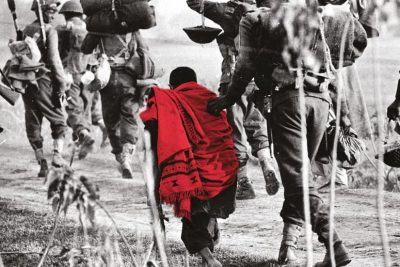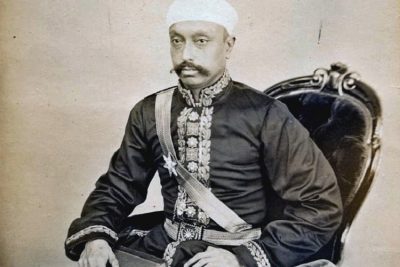The post Saibal Dasgupta on Chinese Art of Trade and What India Can Learn from its Neighbours appeared first on .
]]>
A shop in the streets of Hong Kong, Kowloon, China. (Mstyslav Chernov / Wikimedia Commons)
Growth trajectories of India and China as developing nations are fairly similar. But over the years China has thrived to become the next global superpower, and India is yet to accomplish its goal of becoming the next China. Author and journalist, Saibal Dasgupta in his book Running with The Dragon- How India Should Do Business with China gives detailed yet concise knowhow of achieving the decade’s old dream.
Dasgupta has lived in China for years as a correspondent of the Times of India and has studied and explored the Chinese businesses and markets. He has used this knowledge to guide Indian businesses in setting a foothold in China and subsequently in the world. He presents each chapter in the book with case studies relevant to the topic discussed.
The author questions the readers regarding India’s average trade feat in China despite improved bilateral trades. Besides a handful of IT sector companies, Dasgupta writes Indian traders have not made their mark in China’s difficult yet an advantageous market.
“Barring a few companies, there is hardly any Indian brand presence in China. Few Indian firms have considered it worth their while to attempt this transition from presence to brand and most others think this is higher than the Great Wall to surmount.”
To climb this great wall, Dasgupta suggests traders to consider China a partner and not a rival. And emulate the Chinese expertise and approach of industrial trade to make a presence in the global market. Additionally, recommends testing the economic waters in China and acclimatizing with the industrial locale in the cities. Suggests, Indian Firms to make China their main domain by employing Mandarin-speaking staff. This could prove beneficial in the long term in not just setting up their base in China, but also expanding their businesses in neighbouring countries.
“Establishing factories and offices in China and building a team of experienced Chinese staff could help Indian companies reach out to several other countries where Mandarin is spoken and understood such as Vietnam, Indonesia and to some extent Malaysia.”
Dasgupta in his book speaks to businessmen who have learnt the art of Chinese trading and succeeded in making an impact in local markets there. They have established head offices in China rather than working remotely from India, which had negative impacts on their work earlier. These interviews give a clear understanding of trade functioning with advanced Chinese infrastructure and digital ecosystem unlike the difficult conditions back home in India.
“Some of the major challenges that bog down business or frighten investors in India are absent in today’s China although they existed two decades ago. Infrastructure is not a challenge any more. It is not just that transport facilities are easy and fast, but several other systems like payment mechanisms and the system of obtaining government approvals are digitalized and quick.”
Author, also sheds light on the opportunities present in various sectors, be it the healthcare, R&D, education and even the food industry. Education and healthcare, the author thinks, are India’s strong pursuits and thus India, following in the footsteps of educational giant NIIT, can provide cost-efficient educational programmes as alternatives to expensive courses from American-European competitors.
Saibal Dasgupta’s Book Running with The Dragon-How India Should Do Business with China gives a thoroughly researched and analysed insight into the working of China’s industrial market. Giving, an insider’s view into the market, he suggests Indian businessmen take a leaf out of their books and get a strong footing in China similar to their position in India with companies like Haier, Xiaomi etc. It is a well-structured and documented book with lessons for emerging business persons and policy makers. Written in a simple language, it’s an easy to read and understand book suited for anyone interested and not just for the corporate minds.
More about the book:
 Running with the Dragon- How India Should Do Business with China | By Saibal Dasgupta
Running with the Dragon- How India Should Do Business with China | By Saibal Dasgupta
RELATED
The post Saibal Dasgupta on Chinese Art of Trade and What India Can Learn from its Neighbours appeared first on .
]]>The post Newly Released “From Oberoi to Oyo” – A Close Look into the Revolution of the Indian Hospitality Industry appeared first on .
]]>
Oyo hotel in Shenzhen, China. (Jon Russell / Flickr)
Chitra Narayanan, Delhi-based Journalist gives us a well-researched look into the growth and development of the hospitality industry in India in her book, “From Oberoi to Oyo”. Among other things, she describes how OYO startled the industry and became the fastest growing budget hotel operator in the country. She also gives us some industry insights into the viability of loyalty programmes.
The Coming of OYO
OYO’s founder Ritesh Agarwal set up the hotel brand in 2013, when he was only nineteen years old, registering the new business as Oravel Stays Private Limited. Within three years, the company became a force to reckon with. So much so that, in August 2016, Cyrus Mistry, who was then the chairman of the Tata Group, mentioned OYO as a possible threat at the 115th annual general meeting of Indian Hotels Corporation Limited.
With good reason –
“In 2018, it had 4,50,000 rooms globally and a presence in 500 cities and its target of 1 million rooms appeared to be quite achievable. Its valuation was far more than India’s largest hotel company, the over 100-year-old Taj.”
Chitra Narayanan then talks about how Ritesh Agarwal, who hails from a small town in Odisha and is the youngest of four siblings, began his entrepreneurship journey and got funding for the business. She also goes into detail about how OYO has stayed ahead of its competitors due to its effective application of mobile technology, data science, and an innovative business approach that focused on consumer convenience.
To explain it simply, OYO bridged the gap between what the majority of consumers wanted—branded hotels that were both affordable and comfortable—and the millions of small and inexpensive hotels around the country that would benefit from receiving a standardization in quality.
“Basically, OYO went after the millions of small hotels near railway stations, bus stations etc., and renovated and branded them.”
OYO now aims to become a global brand and is rapidly expanding to other countries. It is also branching into allied verticals and new niches. While it may seem that there is no way but up, Narayana sounds a note of caution:
“Relationships are what make and break companies in this industry and OYO has to crack that piece. The other problem with OYO’s model is its basic burger approach of fast food companies may pall soon as diners crave gourmet offerings.”
Winning Customers with the Loyalty Card
The Indian hospitality industry adopted the concept of loyalty programmes from their U.S. counterparts, and different hotels offer different incentives—discounts, gifts, concert tickets, and so on— to customers to make them want to stay with them
“The reason hotels are big on loyalty programmes is simple. For most hotel chains with a strong programme—be it Starwood (now Marriott) or Taj—40–50 per cent of their occupancy comes from their loyalty card members. Year-on-year the growth is 10 per cent.”
Additionally, by investing in loyalty programmes, the hotels can collect behavioural data on their guests. Using this, they can come up with ideas for providing more personalized services. Furthermore, they can keep tabs on changing trends and adapt to those.
“Thanks to technology and the access to information, we are learning what our guests want,’ Bazin said. In the last forty years, people wanted comfort, good bedding, fire security system, a good shower. Today they want emotions, experience, leisure, they want to see objects, they want interesting colours, design, so today hotels are far less standardized than in the past. This is a good thing as it forces hoteliers to be innovative,’ he added.”
Narayanan mentions the affiliations that many hotels have with different airlines to further enhance the customer experience.
She highlights the drawbacks and limitations of loyalty programmes and offers prescriptions for hotels to get better results from them. She also covers how the hotel industry might benefit from blockchain technology.
“Phocuswright, a travel research authority, pointed out blockchain’s potential to improve hotel loyalty programmes and several interesting use cases. The blockchain-ona-blockchain system, data sharing from different places such as customers’ cryptocurrency wallets, will enable a far more complete and authentic profile of guests, giving clues on their purchasing behaviours. It can also enable better cross-promotions.”
As the author points out in this well-written book, the world is changing, and, whether it is domestically or internationally, consumers now have more power than they ever. The hotel industry will have to keep adapting and improving to stay competitive.
 From Oberoi to Oyo | By Chitra Narayanan
From Oberoi to Oyo | By Chitra Narayanan
Behind the scenes with the movers and shakers of India’s hotel industry
RELATED
The post Newly Released “From Oberoi to Oyo” – A Close Look into the Revolution of the Indian Hospitality Industry appeared first on .
]]>The post Ross Ulbricht: The Creator of the Booming Dark Net E-Commerce Network appeared first on .
]]>
Ross Ulbricht. (U.S. Department of Justice; U.S. State Department)
The Internet is at everyone’s fingertips today, but not many know about the extensive ‘dark net’ lurking right under the surface. The Dark Net consists of complex networks that are accessible by unique and exclusive software, which require specific commands and authorizations in order to follow through with the rather unusual communication protocols. These protocols are followed by both the users, as well as the creators, such that people who use the general internet are unable to access the dark web. Originally, the term darknet referred to networks that were undetectable by ARPANET. It was able to retrieve information from the ARPANET but was virtually invisible. The popularity of Dark Net only increased when a paper was published, “The Darknet and the Future of Content Distribution”.
Applications and special browsing facilities like TOR (The Onion Router) were released to allow people to surf the Dark Net anonymously, keeping their identities safe. Since their identities are well protected, most people have consistently used the darknet as a safe house for free speech and expression, but have lately also resorted to illegal activities surrounding narcotics, human trafficking and extreme scamming. One of the masterminds behind the so-called Dark Net sites that boomed the drug trade around the world is Ross Ulbricht.
Ross Ulbricht: The mastermind of darknet e-commerce
Born on March 27, 1984, Ross Ulbricht graduated from high school in 2002, and attended the University of Texas at Dallas. Availing a full academic scholarship, he graduated with a bachelor’s degree in physics in 2006. After the completion of his undergraduate program, he went on to complete his master’s degree from Pennsylvania State University in 2009, specializing in the field of material science engineering and crystallography.
He also developed an interest in libertarian economic theory and was inspired by political philosophies that were described by the likes of Ludwig von Mises and Ron Paul. His thoughts after graduating were to become an entrepreneur, since he found being in a regular 9-to-5 job while being stuck to a desk rather unsatisfactory. His LinkedIn profile stated, “I am creating an economic simulation to give people a first-hand experience of what it would be like to live in a world without the systemic use of force”. He later went on to start a venture by the name of “Good Wagon Books” with his friend Donny Palmertree, building a platform for the online sale of used or second-hand books.
Silk Road e-commerce
Ulbricht’s ideologies and inspirations led to his eventual vision where he wanted to create a system that maintained anonymity. People could buy or sell any goods that they wanted, with absolute freedom as long as it did not prove to be harmful to other people. The name that came to be of this free market was known as Silk Road which employed the use of Tor and Bitcoin. Tor ensures anonymity whereas Bitcoin is the cryptocurrency that is used for transactions on the Dark Net market. Bitcoin wallets usually are linked to the user’s identity. But in some cases, people can avoid linking their identity, which leads to considerable anonymity during the transactions. However, even if people do not link their identity, it does leave a trail on the internet, which if traced leads back to a delivery address and eventually to the user.
Ross William Ulbricht, however, soon became a felon, who was taken into custody on charges of operating a Dark Net market, online drug trade and his genius behind the creation and operation of “Silk Road”. His alias on the internet was “Dread Pirate Roberts”, a character from a novel and film adaptation of “The Princess Bride”. Several other charges were pressed on him by the United States government which included hacking, money laundering and trafficking of fraudulent identity documents. The FBI seized 144,000 Bitcoins from Ross Ulbricht, which is worth 1.05 billion US Dollar as of today.
The arrest of Ross Ulbricht
Gary Alford, an IRS investigator with DEA, was the first to move in on Ross Ulbricht. The link was made by the username ‘altoid’, which Ulbricht used to address a programming query. Following this, he gave his email address which contained sensitive information related to him, including his full name.
Accused of being the mastermind behind the Silk Road website, Ulbricht was arrested by the FBI, at the Glen Park branch of the San Francisco Library. The incident of his arrest was rather dramatic, but it was effective as they managed to get hold of the incriminating evidence from his laptop. Two agents were in the guise of a quarrelling couple and had sufficiently distracted Ulbricht, after which a third agent retrieved the information required from his laptop by handing it over to Thomas Kiernan who then acquired the files by connecting a USB Flash drive in one of the USB ports.
On August 21, 2014, charges were pressed against Ulbricht and a trial was carried out, succeeding which he was sentenced to double life-imprisonment plus forty years. There was no bail amount set for him because he had committed non-bailable offences, and there was absolutely no possibility of parole. During his trial, there were six murder allegations, out of which five were later dismissed due to lack of evidence.
Ulbricht’s appeals and imprisonment
While it is not entirely known that the pseudonym “Dread Pirate Roberts” was used exclusively by Ulbricht, the government seems to have made their decision. Ulbricht’s trials and sentencing gained a lot of momentum and his supporters appealed for him to be set free and have signed several petitions in order to do so. Ulbricht and his lawyers also filed an appeal claiming that the website was supposed to be an online marketplace that was free and not restricting people and their expression of thoughts. His appeal included arguments which claimed that there were discrepancies in the Fourth Amendment regarding the digital age.
This raised a series of questions on the validity of the constitution regarding technology and its proprietary uses. His appeal was rejected by the United States Court of Appeals and he remains incarcerated for the rest of his life. The Dark Net was a multi-million dollar idea that got Ulbricht the prosperity he so desperately wanted, but it also led to his downfall because of the illicit activities that entailed.
There has been activity under the pseudonym Dread Pirate Roberts even after Ulbricht’s incarceration so it has been clearly indicated that he may not be the only one to use “Dread Pirate Roberts” and we will never know whether or not he was the only creator, the only mastermind behind the legendary “Silk Road”.
Link to the petition to free Ross Ulbricht.
Enjoyed this article? Also, check out “Tim Berners-Lee, the Inventor of World Wide Web: A Leader in the Face of a Revolution“.
Fact Analysis:
STSTW Media strives to deliver accurate information through careful research. However, things can go wrong. If you find the above article inaccurate or biased, please let us know at [email protected].
RELATED
The post Ross Ulbricht: The Creator of the Booming Dark Net E-Commerce Network appeared first on .
]]>The post Saudi Aramco, the World’s Most Profitable Company is a Flag-bearer of Women’s Empowerment & Sustainability appeared first on .
]]>
Saudi Aramco’s headquarters in Dhahran, Saudi Arabia. (Eagleamn / Wikimedia Commons)
Located in Dhahran, Saudi Arabia, is Saudi Aramco, also known as the Saudi Arabian Oil Company is Saudi Arabia’s National Petroleum and Natural Gas Company. It was founded in 1933 and was formerly called the California-Arabian Standard Oil Company, and in 1944 it was known as the Arabian – American Oil Company. However, forty-four years later, in 1988, it came to be known as Saudi Arabian Oil Company or Saudi Aramco.
Saudi Aramco happens to be one of the world’s most profitable companies, according to Bloomberg News that had the opportunity to look at its accounts. Being one of the largest companies in the world in terms of revenue, Saudi Aramco is said to have the second largest daily oil production in the world, as well as the largest crude oil reserves, second only to Venezuela, at approximately 270 billion barrels or more.
In April 2018, Saudi Aramco’s financial data was leaked and analysts at Bloomberg said that the value of the company was at least 1.2 trillion dollars. However, in contradiction to the analysts at Bloomberg, officials at Saudi had estimated the official value of the company to be at least 2 trillion dollars.
Formation of Saudi Aramco
During the First World War, there was a shortage of oil and several American companies had been excluded from Mesopotamia under the “San Remo Petroleum Agreement” of 1920, by the two countries – the United Kingdom and France. However, in 1921, the American secretary of commerce, Herbert Hoover, introduced an “Open Door Policy”.

First oil well in Bahrain, 1931. (Bahraini government)
Among the US companies that had been looking for new sources to obtain oil from abroad, Standard Oil of California (SoCal) was one of them. In May 1932, SoCal hit upon oil in Bahrain through one of its subsidiaries, the Bahrain Petroleum Co. (BAPCO). This incident increased the intrigue revolving around the prospects of oil in the Arabian mainland. However, on 29th May 1933, the government of Saudi Arabia agreed to let SoCal to survey Saudi Arabia for oil, and were granted a concession as opposed to Iraq Petroleum Co. SoCal handed over the concession to California-Arabian Standard Oil (CASOC) which was also one of their subsidiaries.
Having no success with locating oil, in 1936 the Texas Oil Co. (Texaco) bought 50% of the concession. Finally, in 1938, they tasted their first success in Dhahran, where they had their seventh drill site and was called Dammam No.7. It produced over 1500 barrels in one day that gave the company a boost of confidence to continue to grow. In 1944 the name of the company was changed to Arabian American Oil Co. (Aramco), and four years later in 1948, the number of shareholders grew. Standard Oil of New Jersey (also known as Exxon) owned 30% of the company, Socony Vacuum (later known as Mobil) owned 10% of the company whereas Texaco and SoCal each continued to have 30% of the company.

Dammam No. 7, the first commercial well in Saudi Arabia, 1938. (Wikimedia Commons)
Expansion of Aramco
The Gas Initiative was announced in May 2001, by Saudi Arabia and according to the proposal there would be 3 joint ventures with 8 IOCs (International Oil Company) that would be employed for “gas exploration on pure upstream acreage”. The first Core Venture included the regions of South Ghawar and northern Rub’ Al-Khali. The second of these Ventures comprised the Red Sea whereas the third Core Venture included the areas of Shaybah and Kidan. However, in 2003 a partnership was formed between Royal Dutch Shell, Total S.A. and Saudi Aramco in Core Venture 3. Core Venture 1 separated to form three joint ventures where Saudi Aramco held 20% of shares, with Lukoil, Sinopec and Repsol.
In 2004, Aramco had begun to produce at least 8.6 million barrels in one day, and by 2005 they had decided to increase their production and hoped that their capacity would increase to 12.5 million barrels in one day. In order to do so, they launched their five – year plan and doubled their drilling rigs and also increased their refining capacity. In the same year, Saudi Aramco was estimated to have a market value of 781 billion dollars and had established itself as the world’s largest company.
When crude oil prices hiked in June 2008 and exceeded 130 dollars a barrel, Aramco increased their production to 9.7 million barrels per day. However in January 2009, when the prices dropped Aramco announced that they would decrease their production to 7.7 million barrels per day.
Aramco had a turnout of over 400 million scf (standard cubic feet) in one day once it started production from the Karan Gas Field in 2011. In September 2018, the Wall Street Journal stated that Aramco had been thinking about investing 1 billion dollars in international technology firms.
Women’s empowerment
Saudi Aramco has always been aware of the importance of women’s empowerment, and they were one of the first organizations in Saudi Arabia to have hired their first female employee in 1964. Maintaining the ratio of women to men has always been important for the company. Keeping this in mind, Saudi Aramco introduced two programs. The first one was an initiative taken to pay attention to women in business while the second was an initiative that focused primarily on thrusting women into leadership. In the past decade, the organization doubled the women in the workforce. Hiring female engineers has also become one of Saudi Aramco’s priorities, and the company has made special efforts to do so.
Environmental responsibility
For the longest time, concern for the environment has been a Saudi Aramco commitment. In 1963, the company started their very first plan to protect the environment. According to this plan, any form of pollution like air, land, groundwater and land was to be monitored and controlled.
The company has an Environment Protection Department which makes sure that the organization works in an “environmentally responsible” way. Saudi Aramco also promotes recycling programs for paper and printer toner cartridges, as well as several awareness programs. These awareness programs are not only available in company communities, but also community schools. There are many company initiatives, like the Mangrove Seedling Transplantation campaign and cleaning drives for the desert or the beach that have over hundreds of volunteers every year.
The company is also associated with several regional, as well as international, agencies such as Gulf Area Oil Companies Mutual Aid Organization and the International Petroleum Industry Environmental Conservation Association. These associations are a medium of communication between the oil industry and international organizations that discuss several environmental issues.
Enjoyed this article? Also, check out “Vast Oil Reserves Buried Under Rub’ al Khali the Largest Sand Desert in the World“.
Fact Analysis:
STSTW Media strives to deliver accurate information through careful research. However, things can go wrong. If you find the above article inaccurate or biased, please let us know at [email protected].
RELATED
The post Saudi Aramco, the World’s Most Profitable Company is a Flag-bearer of Women’s Empowerment & Sustainability appeared first on .
]]>The post Snakes, Rats, and Unintended Consequences – Understanding the Cobra Effect appeared first on .
]]>
A photo of Cobra. (Luca Boldrini / Flickr)
The cobra effect is a term that is often used in economics and finance to refer to the unintended, unexpected, and unfortunate consequences of an action carried out for a well-meaning purpose or, at least, to bring about an entirely different result.
The origin of the cobra effect
Does it have anything to do with actual snakes? Well, yes, it does. The story goes back to the time when the British ruled the Indian subcontinent, a country famous for its cobra snakes. Unfortunately, the British had no liking for the cobras. They wanted to rule in the capital, Delhi, without having to ever see or encounter these snakes.
To put an end to the deadly menace, the British rulers decided to enlist the help of the local population. The British announced to the locals that they would pay a certain sum of money for each dead cobra that was brought to them as a proof of its death.
The result of this announcement led the Delhiites that had hitherto run in the opposite direction at the sight of a cobra now took to running towards them.
The British were soon inundated with cobra corpses. Months passed and still more kept coming. Who would have imagined that Delhi had so many snakes?
Eventually, the British grew suspicious and sent out people to make discreet inquiries. They discovered from these inquiries that the people of Delhi were a lot more enterprising than the British government had given them credit for.
Once they found that cobras could be a lucrative source of income, they had set up cobra farms to breed them in abundance. Breeding your own cobras was a lot more convenient than having to search for the snakes in the wilderness or in difficult to reach nooks around the city.
Unfortunately for these entrepreneurs, the British government wasn’t thrilled with their business acumen and did not incentivize them further.
The award money for dead cobras was revoked with immediate effect. People arriving with dead cobras were turned away and told never to return again.
That angered the cobra farmers. They had put in so much effort in raising their snakes after all. Was all of that to go for a toss now? The British government remained deaf to their pleas. So, they returned to their farms, took all their cobras, and released them in Delhi.
They made up for the depleted original population of serpents and the city once more became the snake capital of India.
The British found they had only compounded their snake problem while trying to find a solution for it. And this is how the term “cobra effect” was coined.
The French rulers and the Vietnamese rat-catchers
Another popular story about the cobra effect—or, rather, the rat effect in this case—comes from Vietnam when the country was still under the French Colonial rule. The French rulers were annoyed with the over-abundance of rats in Hanoi and, for some reason, they thought it would be a good idea to involve the local population in the culling of the rats. As an incentive, they announced that they would pay a certain sum of money after they had seen the tail of the rat killed.
It turned out to be a popular scheme and, soon, their office was inundated with rat tails. The flood turned into a torrent. The French colonial officers grew sick of seeing rat tails, and, so, they turned their gazes elsewhere—and saw tailless rats scampering about everywhere.
“Mon Dieu!” cried the French officers, as their mental light bulbs lit.
They had been duped by the enterprising Vietnamese rat-catchers. Since there was no business future for them in killing the rats, they had simply cut off their tails and set the rats loose. That way, the rats could continue breeding and produce tailed offspring to keep the money rolling in.
The French shut down the rat-catching scheme as soon as the deception became evident. And, without a financial incentive in catching rats, the rat-catchers turned their attention to other business enterprises. Left unmolested, the rats had the time of their lives. They bred and multiplied, and, once again, overran the offices of the French colonialists. In their attempt to find an effective solution to the rat problem, they had ended up worsening it.
Understanding the Cobra Effect
We all know of Newton’s Third Law, which states that “For every action, there’s an equal and opposite reaction.” Likewise, in the cobra effect, every attempted solution to a problem can bring on a host of unintended and unforeseen consequences.
That’s why decision-makers in finance, economics, and various government services have to take the cobra effect into consideration when they prepare policies of public interest. It can be difficult, however, as it is usually not possible for one person or even a group to consider all the possible scenarios that might arise as a result of a particular decision.
So, rather than unleashing a policy on the public, decisionmakers often find it more prudent to release a part of it, test the reaction to that, and make changes that will make it less likely for people to find something to tamper with. Even so, there is no foolproof defence against the cobra effect.
Enjoyed this article? Also, check out “Laszlo Polgar – The Hungarian Psychologist and Educator Who Raised Three Chess Prodigies“.
Fact Analysis:
STSTW Media strives to deliver accurate information through careful research. However, things can go wrong. If you find the above article inaccurate or biased, please let us know at [email protected].
 Recommended Read:
Recommended Read:
The Cobra Effect | By Christy Esmahan
Genre:
Fiction > Science fiction
RELATED
The post Snakes, Rats, and Unintended Consequences – Understanding the Cobra Effect appeared first on .
]]>The post The Secret Behind the Centennial Light that Continues to Defy Planned Obsolescence appeared first on .
]]>
Livermore’s Centennial Light Bulb defying planned obsolescence. (LPS.1 / Wikimedia Commons)
The Centennial Light, which is the longest-lasting light bulb in the world, is one month short of turning 118-years-old. Located inside the Fire State No 6 in Livermore, California the bulb has been burning since June of 1901.
The Livermore-Pleasanton Fire Department continues to maintain the Centennial Light. In 1901, the bulb was either a 30-watt or a 60-watt one, but today it has become as dim as a 4-watt night bulb.
The longest-burning bulb
The General Electric, The Guinness Book of World Records and even the Ripley’s Believe It or Not!, are said to have recognised the bulb as the longest-burning bulb.
Manufactured by the Shelby Electric Company of Ohio during the 1890s, the hand-blown bulb has a carbon-filament. The person who invented the Centennial Light bulb was a person named Adolphe A. Chaillet.
Generally, an incandescent light bulb functions electrical current passes through a wire filament. When the wire gets hot, it glows and spreads light across the room. The wire filament is placed inside a bulb, which is either a vacuum or filled with some inert gas.
The Centennial Bulb has a carbon filament
In contrast, the Centennial Bulb has a carbon filament. As the bulb gets hotter, it creates a lower electrical resistance. It also has a durable vacuum seal. That is, perhaps, the reason behind its longevity. However, the same factor makes the bulb ineffective.
Also, the carbon-filament bulbs are very sensitive to power fluctuations and, therefore, they are inconsistent and inefficient in comparison to modern light bulbs.
As the Centennial Light bulb was connected to the local power grid, it had no back-up power source. As a result, it faced quite a few power outages.
Human error or intervention
On several other occasions, human error or intervention caused the Centennial Light has been switched off. Otherwise, the bulb neither ceased to brighten up the fire station nor burned out.
Once in 1903, the bulb was removed and shifted to the Fire Station 1 in McLeod area. Again in 1937, when the Fire Station was renovated, the bulb was switched off for seven days.
Again in 1976, the Centennial Light bulb was deprived of electricity for 22 minutes when it was shifted to its present address. On May 20 of 2013, when the UPS failed at its current address, the light in the bulb was off for about 9 hours 30 minutes.

The Centennial Light at Livermore-Pleasanton Fire Department. (John Fink / Flickr)
The mystery behind this time-defying bulb
After the power supply resumed the bulb shined with 60-watt brightness for a few hours. Is there a mystery behind this time-defying bulb? It is not clear as to what did the Shelby Electric Company do to manufacture such time-defying bulbs in 1901.
Writing for Collectors Weekly, writer Hunter Oatman-Stanford confirms that during the early 1900s, electric companies were serving the first homes with electricity.
Explaining on the system in those days, he said power consumers were purchasing all the electrical systems from a regional supplier. He used to handle the installation and upkeep of the equipment and the power supply.
Representatives of the regional supplier replace the bulbs for free if the filament in the bulbs were burned out due to overheating. As this business model was not raking in profits, the electric companies told the consumers to buy and replace their own bulbs.
It was then that the electrical companies started to manufacture cheap bulbs that burn out frequently and earn profits to the companies. By 1910, electrical companies were charging roughly $33 for a lamp that served for 1,500-hours. This is somewhat the same lifespan of today’s luminous bulb.
Planned obsolescence
Such a business model is known as planned obsolescence. In this model, products are designed to have a short expiration time that forces consumers to purchase the product repeatedly. This means that all products are being designed to fail since the 1950s. As a result, consumers appear to have completely accepted the concept of cyclic purchasing.
Under the concept of cyclic purchasing, consumers are embarrassed if they fail to constantly replace their electronic devices or fashion items. The stigma of driving an old car is a big thing in today’s consumer-driven world.
Coming back to the short life span of a light bulb, this concept forces us to assume that this is what the engineers can do at the most. A normal incandescent bulb lasts for 2,000 hours or roughly 83 days if used constantly. In contrast, the LED bulbs last for 50,000 hours or roughly 5.7 years. Once these bulbs expire, they are thrown out as waste.
Planned obsolescence generates huge waste every year
What does this mean? It means that planned obsolescence generates huge waste every year. The waste multiplies over a period of time and poses a threat to the global environment. It is not for nothing that planned obsolescence is slammed.
The Centennial Light is a good reminder that societies that are technologically advanced do not give us access to highly advanced technology.
Why the Centennial Light bulb is so different?
In such a global economic scenario, why the Centennial Light bulb is so different? According to Tom Bramwell, a retired deputy fire chief at Livermore, the Centennial Bulb’s longevity can be attributed to an honest American’s craftsmanship.
The Phoebus Cartel formed
However, in the 1920s, top light bulb producers like General Electric, Osram, and Philips had formed the Phoebus Cartel. They colluded to make fragile light bulbs, stifled innovation and fixed prices.
The cartel standardised a 1,000-hour bulb life and enforced obsolescence and made profits by fleecing the consumers. This is a sure shot case of planned obsolescence that worked for a while.
Apple also came under fire
After World War II the cartel collapsed following the increased competition. In 2017, when Apple, the consumer electronics giant, tried to slow down the batteries of older iPhone models, it was slammed internationally. Apple also came under fire for problems with its MacBook Pro models.
Though planned obsolescence could be okay in some industries, governments and consumers fight back at times. For instances, the French government investigated if Apple wanted to manufacture aged iPhones obsolete. The European Union, meanwhile, ensures that appliance manufacturers make products that meet durability standards.
In spite of these attempts to remove the effects of planned obsolescence, it continues even today as the symbol of corporate greed.
Three types of planned obsolescence strategies
There are broadly three types of planned obsolescence strategies in the consumer product world. Interestingly, planned obsolescence can be a success through unreliable parts, software that fails and clever marketing.
Even as today’s manufacturers and consumers grapple with planned obsolescence, the Centennial Light continues to brighten the Fire Station in the US. It’s a picture of craftsmanship.
In spite of these attempts to remove the effects of planned obsolescence, it continues even today as the symbol of corporate greed.
Enjoyed this article? Also, check out “Snakes, Rats, and Unintended Consequences – Understanding the Cobra Effect“.
Fact Analysis:
STSTW Media strives to deliver accurate information through careful research. However, things can go wrong. If you find the above article inaccurate or biased, please let us know at [email protected].
RELATED
The post The Secret Behind the Centennial Light that Continues to Defy Planned Obsolescence appeared first on .
]]>















